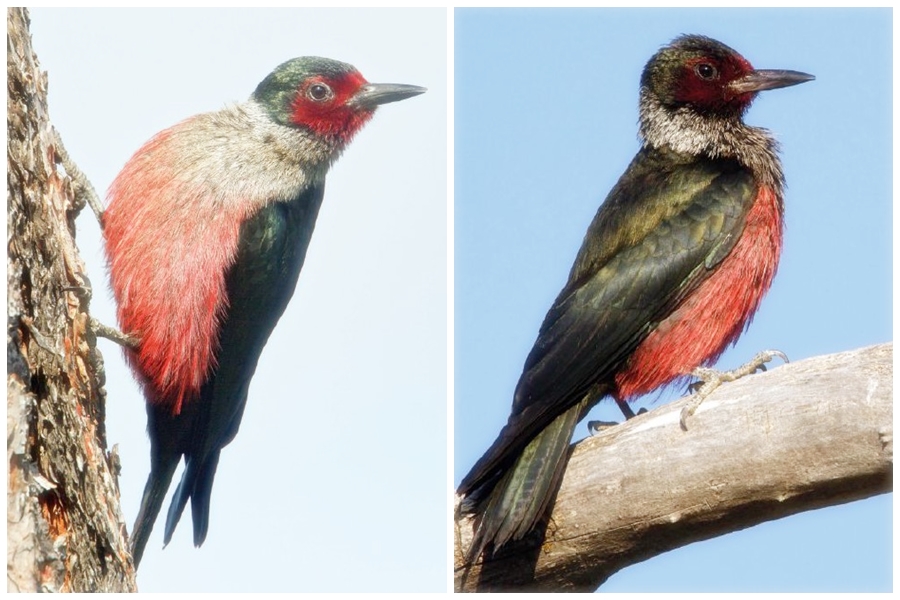The Lewis’s Woodpecker (Melanerpes lewis) measures approximately 26–29 cm in length. The bird was originally discovered by Meriwether Lewis, one of the explorers who surveyed the areas bought by the United States through the Louisiana Purchase. This species of woodpecker was named after him by ornithologist Alexander Wilson.
There are many different species of woodpeckers, but this one is large, long-tailed, and long-winged. The adult Lewis’s Woodpecker is a stunning species. As one of the rare woodpeckers without sexual dimorphism, it is not characterized by sub-specific plumage variations.

The birds fly straight, flapping, corvid-like, and look black in flight. It has a glossy bottle-green crown, most of the head, and upper parts. An adult with crimson lores, cheeks, and ocular areas. A broad collar of silver-gray appears on the nape, neck, and chest.
Throughout the body, there is a salmon-pink tint that tinges the belly, flanks, and breast. Undertail and wings are darker green, wings are lighter green. The outer tail sometimes has some white. Grey-black bill and bluish-grey legs with an Iris chestnut color. Juvenile woodpeckers look similar to adults, but their faces and collars are duller, less glossy, and their bellies are mostly barred.
Unlike other woodpeckers, Lewis’s Woodpecker prefers to remain silent. There are three to eight rough, muffled, and harsh notes in the male territorial song. But it is short, rapidly repeated. There are teef-like sounds and kitsif calls characteristic of Lewis’s Woodpeckers, but they are a bit weak.
An additional rick-rick-rik call that is high in pitch and falls, as well as a dry, squeaky rattle and chatter that recalls European Starlings. Males’ alarm calls are a single, soft yick; females’ are a two-syllable yick.
Male drumming is frequently accompanied by churr sounds. The roll calls are mainly mild, quiet, and medium-speed, with single knocks spaced by a distance. Outside of the breeding season, he rarely drums. Drumming is probably not done by female birds.
Agricultural and urbanization are causing habitat loss, as well as fire control and pesticide use, in many areas. In spite of local declines and a steady decline over time (since the 1960s), the species is not listed as threatened.
Open, deciduous temperate woodlands with dry and damp conditions are its habitat. There are also cottonwood stands along the riparian zone. Breeding often occurs in postburn pine woods. In contrast to other American woodpeckers, it prefers to sit in the open rather than under dense foliage. The birds visit oak forests, nut groves, plantations, and orchards up to 2800 meters above sea level during the winter.
During the breeding season, Lewis’s woodpeckers nest in cavities excavated from dead tree branches. Males are primarily responsible for constructing nests. The female lays between five and nine eggs, which are white in color. It is the female who incubates during the day, while it is the male who does so at night. Hatching takes place after approximately 12 days. Within four to five weeks of hatching, the young leave the nest.
North America is the range of Lewis’s Woodpecker. A large population of this species breeds in southwest Canada and the United States along the western edge of the Great Plains, from New Mexico to Arizona, mirroring the distribution of Ponderosa pines.
In some populations, food availability determines their location, while in others, they disperse. Migration is common among northernmost birds; they leave breeding areas in August and September, spend winters in the southwest United States and northwestern Mexico, and return in spring.
As a result of habitat loss and degradation, Lewis’s Woodpeckers’ conservation status needs to be reviewed. There is a monotypic taxonomy and variation. The variation is slight and unmistakable. Rather than other woodpeckers, migrant flocks suggest Pinyon Jays or crows.
For foraging and food, this is an expert flycatcher. In order to catch emerging adult insects, it usually perches on snags and fence posts. Acorns and fruit are its main winter food sources, shelled by anvils and stacked in tree bark crevices. These caches are often the subject of fierce disputes with Red-headed and Acorn Woodpeckers. A ground forager is also present.
Related Reading: Maroon Woodpecker (Blythipicus rubiginosus)







